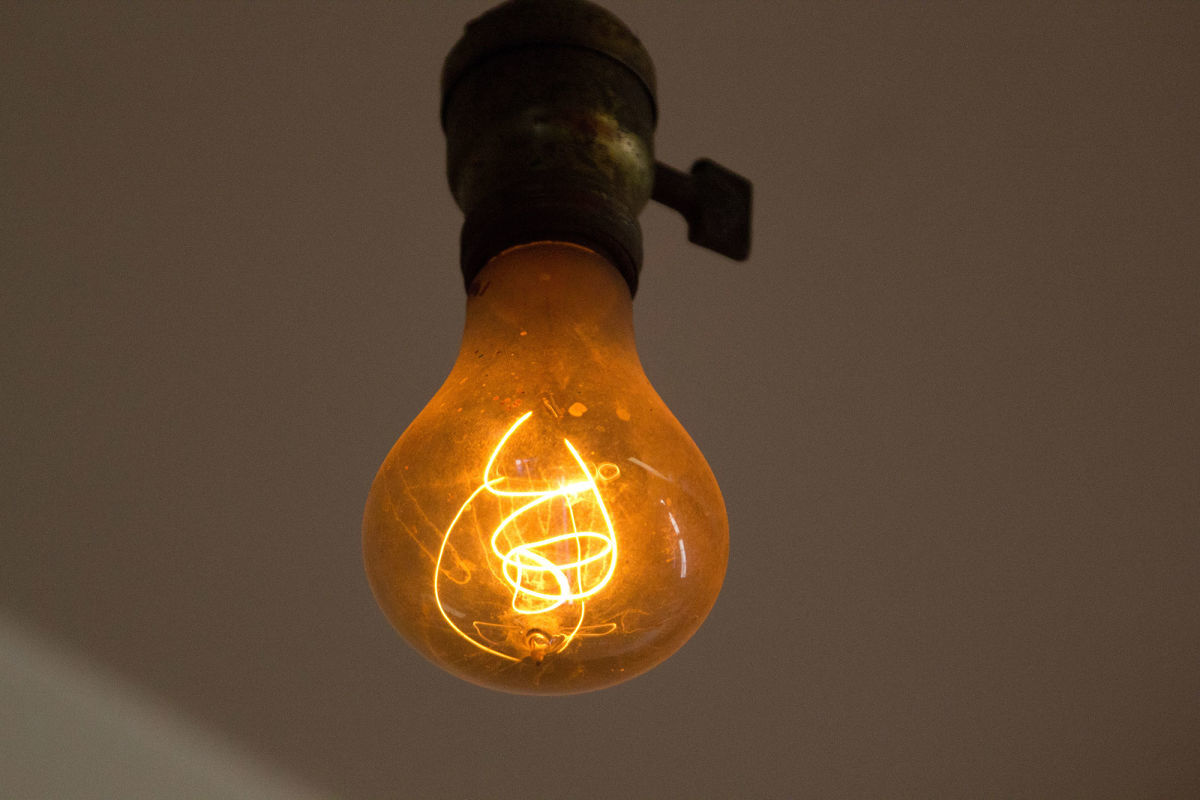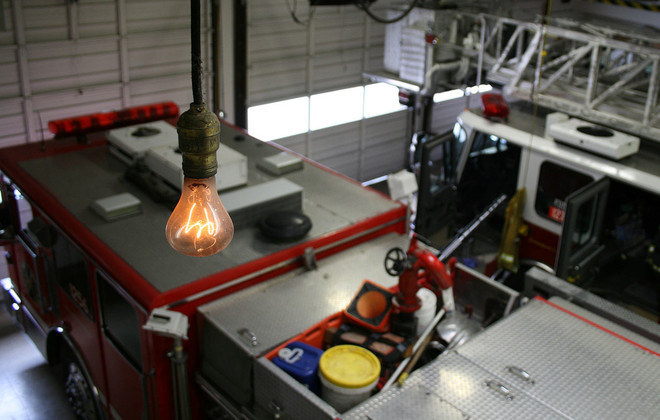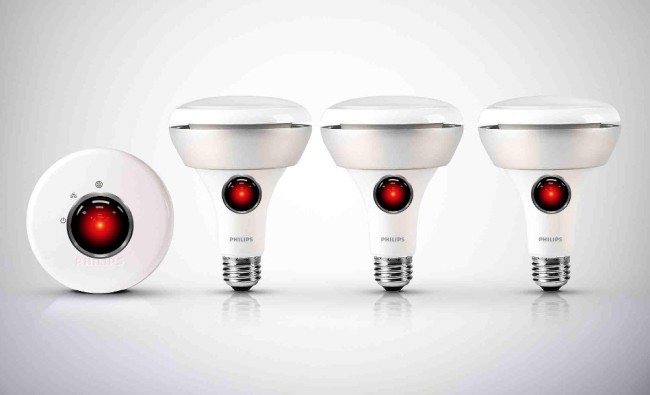LED bulb manufacturers solve the problem of too long service life

The light bulb at the Shelby Electric fire station in Livermore, California has been shining almost continuously since 1901, for more than 1 million hours. In 2015, it is listed in the Guinness Book of Records as a light bulb with the longest service life . Photo: Dick Jones / EPA
On December 23, 1924, representatives of the largest companies producing lighting fixtures met in Geneva (Switzerland) and agreed on the creation of the Phoebus , probably the first industrial cartel in the history of the world. Companies discussed the problem of product quality. The problem was that the quality of incandescent bulbs increased too much, and the duration of their service threatened the business. In other words, the lamps served for so long that they began to decline in sales.
As a result of the contract, the standard life of incandescent lamps was reduced to 1000 hours. This contract is considered one of the first examples of planned obsolescence on an industrial scale, and the service life of approximately 1000 hours has been preserved to this day.
It is noteworthy that with the start of sales of new models of manufacturers, manufacturers explained: the reduction in operating time is due to the fact that it is necessary to establish quality standards in terms of illumination and energy efficiency. But historians who study the archival documents of Phoebus say that in the new models there was only one significant technical innovation: a shorter filament life. Bulbs just before burned out.
')
Today, manufacturers of LED lamps face the same problem. A conventional LED lamp has a service life of 25,000 hours, according to the standard, after which they lose more than 30% of their brightness. Subject to continuous operation, this is 1041 days, that is, slightly less than three years. In a typical American household, the light bulb does not work around the clock, but on average 1.6 hours per day. Thus, the LED lamp will last for about 43 years, and there are LED lamps on the market with a service life of 50,000 hours. What kind of sustainable business can you count on by selling such products?
Nowadays, the planned obsolescence of products has become a normal technological method, not only for light bulbs, but also for consumer electronics, smartphones, computers, cars and other goods. Moreover, the planned obsolescence and the cult of consumption is considered to be a stimulus for the economy and is supported nationwide. During the Great Depression in the United States, some economists called the planned obsolescence of products "new god" for business . Approximately since then, the thesis of the need to maintain “re-consumption” through planned obsolescence has become an almost immutable economic axiom. He formed the basis of the entire consumer economy of our time, without which it is difficult to imagine modern society. Now people work for years 10 hours a day without holidays, in order to be able to buy new products in return for old ones that are outdated as planned.
Until the 1924 cartel agreement, incandescent bulbs worked longer than many modern products. The light bulb at Fire Station No. 6 in Livermore is an outstanding example of the reliability of the products of that time. With a rated power of 60 W, this manually blown lamp now operates at about 4 W, but still provides night-time lighting for fire engines at the station around the clock. Although now it performs a rather decorative function, but earlier the lamp hung below, and at the sound of a fire alarm, before leaving, each fireman considered it his duty to slam it for good luck.

The lamp was made in about 1900 by engineers from the small American company Shelby Electric from Ohio, designed by the French-American inventor with Russian roots Adolphe Chaillet. The exact design of the record holder has not been thoroughly studied. It was one of the many experimental light bulbs. At that time, Shelby Electric experienced many different types of design. It is only known that it uses a carbon filament about the thickness of modern incandescent filaments, usually made of tungsten.
In the near future, the "old woman" from the Livermore Fire Station will be retired and given to storage (possibly to a museum). But she still has not burned out. This light has already become famous, and its glow transmits to the Internet a special webcam .

The Shelby Electric company was bought in 1912 by a large General Electric corporation, one of the participants of the cartel collusion of 1924, in which the Dutch Philips, the German Osram and the French Compagnie des Lampes also participated. The contract between corporations ensured their financial prosperity for decades to come. Many of these manufacturers are still engaged in the usual business. Now an immediate threat to them are LED bulbs.
As households are increasingly buying LED lamps instead of ordinary incandescent lamps, large corporations are now approaching the same dangerous line that their predecessors approached more than 90 years ago: sales are threatening to decline. Now LED lamps occupy about 7% of the world market. According to analysts, by 2022 their share will increase to 50%. In the first quarter of 2016, according to the National Association of Electrical Equipment Manufacturers in the USA, sales of LED lamps in the United States increased by 375% over the same period last year, and their share in the US market for the first time in history exceeded 25%.
To say that manufacturers start to panic will be an understatement.
There are some clues that firms are trying to use the old Phoebus trick to limit their lifespan by making cheaper products. For example, Philips sells for $ 5 LED-bulbs with a lifespan of 10,000 hours. Chinese manufacturers generally do not think too much about durability, releasing a lot of cheap low-quality products that are sold almost by weight.
But nowadays it is impossible to arrange the same cartel collusion as in 1924, too many manufacturers are involved in this business, and the 25,000-hour LED lamp resource has become almost a standard. Therefore, manufacturers have to invent something else, writes New Yorker .
One of the logical methods is to make ordinary LED lamps a part of another, larger product, for which it is possible to preserve the planned obsolescence. Manufacturers are counting on the fact that ordinary bulbs of the past will become part of "smart" systems of intelligent home lighting. For example, Philips manufactures a line of smart LED bulbs and Hue controllers. Such bulbs intelligently change the brightness and temperature of the light (16 million colors), and also combine into a network. They work on the standard network protocol Zigbee, so that third-party Zigbee-bulbs also have the ability to connect to a single network.

Philips Hue LED Bulbs
Six months ago, the Philips company showed an example of another non-standard reception, which gives an idea of how the manufacturers of light bulbs intend to fight for their place in the sun. In December 2015, she released a firmware update for the proprietary network bridge, which began to block access to the Hue API for any “not approved” light bulb. Approved are those who received the certificate “Friends of Hue” (Friends of Hue). The rest will have to disconnect from the Philips background lighting network and work autonomously. Cree, GE, Osram and others are among the rejected ones.
Thus, the manufacturers of light bulbs began to use for their own benefit the legislation on the protection of intellectual property, and specifically the notorious DMCA law.
It is possible that manufacturers expect that on the Internet of Things laws like the DMCA will allow them to implement something like a modern digital “planned obsolescence”, when old lamps will not be compatible with more modern electronics / software / interfaces. Although physically they could work for many years, but de facto consumers will be pushing to buy new models, as buyers of smartphones are now forced to do because of the constant modernization of the ecosystem, the constant release of new OS versions and software that is incompatible with older OS versions. Studies in Europe have shown that consumers change smartphones, on average, every 2.7 years. This is an ideal example to follow from the manufacturers of lighting fixtures. Light bulbs should also become part of the rapidly evolving and aging hardware-software ecosystem of the “Internet of Things”.
In any case, one thing is clear: the company is not able to survive in conditions if it manufactures products with a service life of 43 years. Competition from the same Chinese manufacturers simply forces Western corporations to figure out how to transform the business and make a new “product” based on ordinary light bulbs. They simply have no choice but to promote intelligent lighting systems and concepts like “Internet of Things”, “Smart Home” and others.

It seems that manufacturers have come to terms with the inevitable. A month ago, Philips allocated a lighting business to a separate company, Philips Lighting, which is preparing for an IPO. German Osram - another one of the largest manufacturers of lighting lamps - also singled out its $ 2 billion lamp manufacturing business to the independent company Ledvance, which is now on sale. And in October last year, the same thing was done by the American General Electric, the third participant in the 1924 cartel agreement, founding GE Lighting, a subsidiary that would be easy to sell.
LED lamps - perhaps the first mass product of the 21st century, which challenges the current concept of planned obsolescence.
 Let's see what happens. Economists say that the transition of society to high-quality goods with a long service life will require radical, systemic changes in the consumer economy, which are likely to cause a slowdown in economic growth in the short term. “This may be unacceptable for governments that use economic growth as a primary indicator of productivity,” wrote Tim Cooper, the head of the research group on sustainable consumption at the University of Nottingham, in his book Longer Lasting Products . But he believes that sooner or later, mankind will be forced to abandon consumerism in its current form and switch to using products with a long service life, repaired, with replaceable parts. This will inevitably have to be done simply for the reason that the ecological and material resources of our planet are limited and cannot ensure the endless growth of consumption.
Let's see what happens. Economists say that the transition of society to high-quality goods with a long service life will require radical, systemic changes in the consumer economy, which are likely to cause a slowdown in economic growth in the short term. “This may be unacceptable for governments that use economic growth as a primary indicator of productivity,” wrote Tim Cooper, the head of the research group on sustainable consumption at the University of Nottingham, in his book Longer Lasting Products . But he believes that sooner or later, mankind will be forced to abandon consumerism in its current form and switch to using products with a long service life, repaired, with replaceable parts. This will inevitably have to be done simply for the reason that the ecological and material resources of our planet are limited and cannot ensure the endless growth of consumption.Source: https://habr.com/ru/post/396037/
All Articles